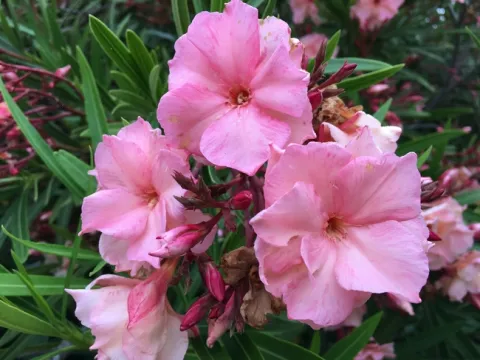
Oleanders
By Linda Lewis Griffith UCCE Master Gardener
Nerium oleander
Planting Zone: Sunset zones 8-16, 18-23; USDA 8-10
Size: 8-12 feet tall and wide. However, plants can be as small as 3-4 feet or as tall as 20 feet.
Bloom Season: May or June to October
Exposure: Most varieties thrive in heat and strong light, even reflected heat from pavement. May also tolerate partial shade.
Pruning Needs: Prune in early spring to control size and form
Water Needs: Withstands considerable drought and poor drainage
Narrative: Oleanders are fast growing plants that are able to grow in challenging environments. Ordinarily broad and bulky, they can be trained into attractive single- or multi-trunked trees that bear a resemblance to olive trees and give oleanders their name.
Frequently overlooked because of their association with freeways and parking lots, oleanders have attractive, even showy, flowers. Some varieties have fragrant blooms. Others include double and single flowers forms, with colors ranging from white to shades of yellow, pink, salmon and red.
Oleanders are used in a variety of settings, including windbreaks, visual screens and borders for roads or driveways. They are especially valuable where deer are a problem as the animals completely avoid them.
Oleanders are one of the most poisonous commonly grown garden plants. All parts are toxic if eaten. Caution children against eating leaves or flowers; keep clippings and dead leaves away from hay or other animal feed. Never use as wood for campfires, barbeques or skewers as the smoke can cause irritation.
Oleanders are susceptible to several plant diseases and pests. Common bacterial infections are oleander knot disease and the potentially fatal bacterial leaf scorch. Fungal infections include leaf spot and Botryosphaeria dieback. Simple sanitation measures help keep problems under control: remove and destroy infected plants, avoid overhead watering and clean pruning tools with disinfectant. Aphids and scale can also damage leaves and shoots. Both pests produce a sugary liquid called honeydew which coats the leaves and branches. Black sooty mold often grows atop the honeydew and leads to premature leaf drop. Control measure for aphids and scales include ladybugs and other natural predators, as well as horticultural oil and insecticidal soap.

